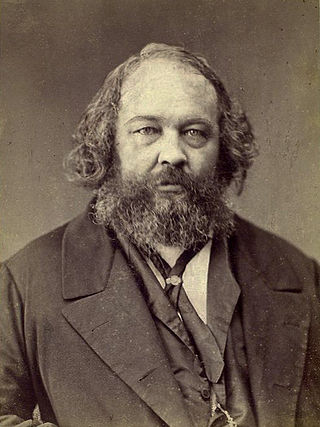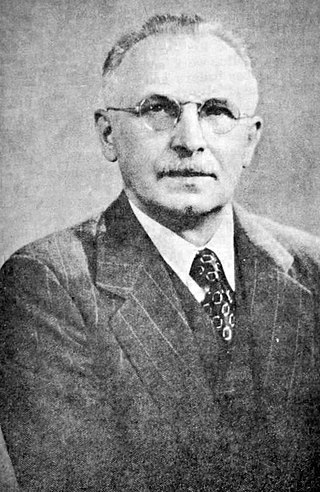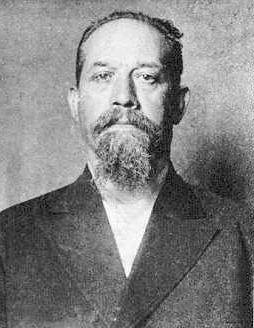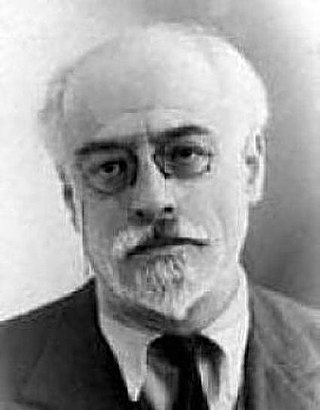Related Research Articles

Mikhail Alexandrovich Bakunin was a Russian revolutionary anarchist. He is among the most influential figures of anarchism and a major figure in the revolutionary socialist, social anarchist, and collectivist anarchist traditions. Bakunin's prestige as a revolutionary also made him one of the most famous ideologues in Europe, gaining substantial influence among radicals throughout Russia and Europe.
Sam Dolgoff was an anarchist and anarcho-syndicalist from Russia who grew up and lived and was active in the United States.

August Vincent Theodore Spies was an American upholsterer, radical labor activist, and newspaper editor. An anarchist, Spies was found guilty of conspiracy to commit murder following a bomb attack on police in an event remembered as the Haymarket affair. Spies was one of four who were executed in the aftermath of this event.

Grigorii Petrovich Maksimov was a Russian anarcho-syndicalist. From the first days of the Russian Revolution, he played a leading role in the country's syndicalist movement – editing the newspaper Golos Truda and organising the formation of factory committees. Following the October Revolution, he came into conflict with the Bolsheviks, who he fiercely criticised for their authoritarian and centralist tendencies. For his anti-Bolshevik activities, he was eventually arrested and imprisoned, before finally being deported from the country. In exile, he continued to lead the anarcho-syndicalist movement, spearheading the establishment of the International Workers' Association (IWA), of which he was a member until his death.
The history of anarchism is as ambiguous as anarchism itself. Scholars find it hard to define or agree on what anarchism means, which makes outlining its history difficult. There is a range of views on anarchism and its history. Some feel anarchism is a distinct, well-defined 19th and 20th century movement while others identify anarchist traits long before first civilisations existed.

Paul Avrich was a historian of the 19th and early 20th century anarchist movement in Russia and the United States. He taught at Queens College, City University of New York, for his entire career, from 1961 to his retirement as distinguished professor of history in 1999. He wrote ten books, mostly about anarchism, including topics such as the 1886 Haymarket Riot, 1921 Sacco and Vanzetti case, 1921 Kronstadt naval base rebellion, and an oral history of the movement.

Luigi Galleani was an Italian insurrectionary anarchist best known for his advocacy of "propaganda of the deed", a strategy of political assassinations and violent attacks.

Vsevolod Mikhailovich Eikhenbaum, commonly known by his pseudonym Volin, was a Russian anarchist intellectual. He became involved in revolutionary socialist politics during the 1905 Russian Revolution, for which he was forced into exile, where he gravitated towards anarcho-syndicalism.
Anarchism in Russia has its roots in the early mutual aid systems of the medieval republics and later in the popular resistance to the Tsarist autocracy and serfdom. Through the history of radicalism during the early 19th-century, anarchism developed out of the populist and nihilist movements' dissatisfaction with the government reforms of the time.

Golos Truda was a Russian-language anarchist newspaper. Founded by working-class Russian expatriates in New York City in 1911, Golos Truda shifted to Petrograd during the Russian Revolution in 1917, when its editors took advantage of the general amnesty and right of return for political dissidents. There, the paper integrated itself into the anarchist labour movement, pronounced the necessity of a social revolution of and by the workers, and situated itself in opposition to the myriad of other left-wing movements.

Wilhelm Ludwig "William" Rosenberg was a German-American teacher, poet, playwright, journalist, and socialist political activist. He is best remembered as the head of the Socialist Labor Party of America from 1884 to 1889.

Paul Grottkau (1846–1898) was a German-American socialist political activist and newspaper publisher. Grottkau is best remembered as an editor alongside Haymarket affair victim August Spies of the Chicagoer Arbeiter-Zeitung, one of the leading American radical newspapers of the decade of the 1880s. Later moving to Milwaukee, Grottkau became one of the leading luminaries of the socialist movement in Wisconsin.

The Socialist Labor Party (SLP) is the first socialist political party in the United States, established in 1876.
Marie Le Compte was an American journal editor and anarchist who was active during the early 1880s.

The International Working People's Association (IWPA), sometimes known as the "Black International," was an international anarchist political organization established in 1881 at a convention held in London, England. In America the group is best remembered as the political organization uniting Albert Parsons, August Spies, and other anarchist leaders prosecuted in the wake of the 1886 Haymarket bombing in Chicago.

Freie Arbeiter Stimme was a Yiddish-language anarchist newspaper published from New York City's Lower East Side between 1890 and 1977. It was among the world's longest running anarchist journals, and the primary organ of the Jewish anarchist movement in the United States; at the time that it ceased publication it was the world's oldest Yiddish newspaper. Historian of anarchism Paul Avrich described the paper as playing a vital role in Jewish–American labor history and upholding a high literary standard, having published the most lauded writers and poets in Yiddish radicalism. The paper's editors were major figures in the Jewish–American anarchist movement: David Edelstadt, Saul Yanovsky, Joseph Cohen, Hillel Solotaroff, Roman Lewis, and Moshe Katz.
Justus H. Schwab (1847–1900) was the keeper of a radical saloon in New York City's Lower East Side. An emigre from Germany, Schwab was involved in early American anarchism in the early 1880s, including the anti-authoritarian New York Social Revolutionary Club's split from the Socialistic Labor Party and Johann Most's entry to the United States.
Wilhelm Hasselmann was a German socialist politician and activist and editor of various social democratic newspapers.
The Congress of Socialists of the United States, better known as the 1881 Chicago Social Revolutionary Congress, was a meeting of anarchists and socialists in Chicago in October 1881 to organize the new social revolutionary groups splintered from the American Socialistic Labor Party.

Mikhail Bakunin's Confession is an 1851 autobiographical work written by the imprisoned anarchist for clemency from Russian Emperor Nicholas I.
References
- 1 2 Avrich 1984, p. 49.
- ↑ Avrich 1984, pp. 50–51.
- 1 2 Avrich 1984, p. 466.
- 1 2 Avrich 1984, pp. 49–50.
- ↑ Avrich 1984, p. 50.
- ↑ Avrich 1984, pp. 58–59.
- ↑ Avrich 1984, p. 64.